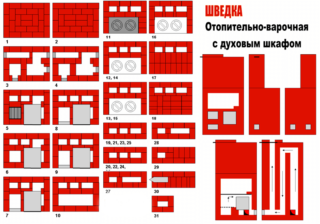Combined stoves are often used to heat small country houses. One of the most successful examples is the Swedish heating and cooking stove. In terms of efficiency, it is somewhat inferior to traditional Russian, but it takes up less space.
- Advantages and disadvantages
- The principle of operation and design of the Swedish oven
- Structural and functional features
- Similar constructions
- Dimensions and drawings of the Swedish stove
- The sequence of the construction of the furnace
- Materials (edit)
- Furnace masonry tools
- Foundation construction
- Ordering
- Features of pipe laying
- Useful Tips
Advantages and disadvantages
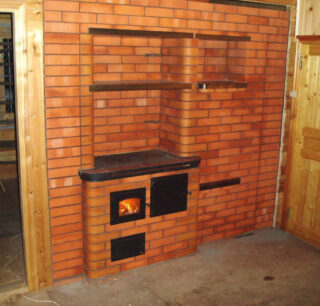
The Swede is a symbiosis of a high vertical design for heating a room and a hob for the kitchen. It is best to install it in an interior partition, so that the heating surface is inside the living room, and the cooking surface is from the kitchen side. In this case, the kitchen space is heated during cooking, and the living quarters are constantly heated.
The design has many advantages.
- High functionality - the stove heats rooms, allows you to heat water, cook and fry food, bake pies, heat ready meals, dry both food and things.
- The design is economical. Its vertical part is equipped with many complex chimney ducts, through which exhaust gas circulates for a long time, completely giving off heat to the room.
- The Swedish brick oven seems compact. In fact, its working area is almost not inferior to the Russian one, but due to its design and location, it seems small and does not occupy living space.
- Allows you to warm up 2 rooms at once. With a small area, you can heat the whole house.
- Literally everything is used as fuel: coal, wood chips, logs, branches, even reeds and dry weeds.
- The Swede keeps heat for a long time and is not inferior to the “Dutchwoman” in this: one firebox is enough to keep the rooms at a stable temperature for at least 12 hours.
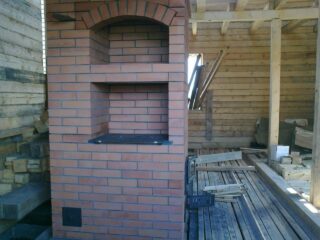
Minuses:
- The Swedes are quite demanding on the material. It is laid out from the highest quality chamotte.
- The design is very complex. Its construction requires a lot of experience and skill. Beginners cannot do this.
Some models can work in "summer" mode, only to service the hob. In this case, a damper is installed inside, which closes the smoke flows. In this case, the exhaust gas immediately goes into the chimney.
The principle of operation and design of the Swedish oven
The efficiency of the unit in the room is ensured by the numerous chimney ducts. Here, the exhaust gas circulates in several circles along the surface and only then goes into the chimney. An important feature is that the firebox is located on the side of the hob. This allows you to transfer the design to the summer mode.
Usually, the ducts in the heating block are arranged vertically. But if the stove is equipped with a stove bench, horizontal channels are formed here. The smoke here passes through the overflow window located above the oven.
The kitchen unit includes a firebox, a hob placed directly above it, an oven, a niche above the hob, and an upper niche. Each of these elements carries a functional load.
- The oven is installed in the depths of the combustion chamber. It is intended for cooking and as a heat exchange element.The Swede does not have an annealing hood or vault, so the heat quickly escapes into the chimney. The oven retains the exhaust gas, thereby making it possible to immediately take the required amount of heat and transfer it to the Swedish heating block.
- The niche above the hob is for cooking and storing food. The hole in the niche can be closed with a wooden shield, which allows you to keep food warm and not reheat it.
- An upper niche is placed above it. Initially, its purpose is a place to dry things. In the Scandinavian countries, the climate is harsh, clothes often freeze over. Drying it out in the room is quite difficult. Nowadays it is used for heating wearable items in very cold seasons, as well as for drying and drying fruits and mushrooms. An option is also built without an upper niche.
The construction of the Swede can be modified: change the ordering scheme, delete some elements or form new ones. But at the same time, it is important to take into account how and under what conditions the heated gas passes, so as not to reduce the efficiency.
Structural and functional features
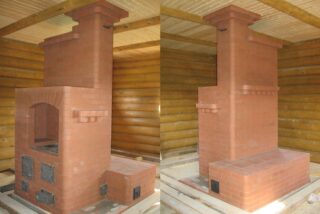
A Swedish stove for a summer residence includes several functional elements. In order for them to achieve maximum efficiency, certain conditions must be observed.
The traditional hob for this design is a thick cast iron plate with two burners. Dimensions correspond to 410 * 710 mm. The height of the location depends on the height of the firebox, but it is not recommended to put it below 120 cm, otherwise it will be inconvenient to use the burners. It is possible to replace cast iron with iron sheet, but not recommended. Cast iron accumulates heat better and on such a burner you can heat food after the end of the furnace.
Flue ducts in the body of the heating unit can be positioned vertically and horizontally. The second option is typical for benches, but it can also be used in a vertical design. The first modification is more advantageous in that it is less dirty, less soot and soot accumulate here, so you can rarely clean the stove. However, it warms up worse at the bottom. The model with horizontal channels guarantees uniform heating. But such a system must be equipped with additional cleaning holes, since soot is deposited here much faster.
It is better to make an oven with your own hands from cast iron for the same reasons. In suburban small structures, models made of iron and even tin are often found. This option is short-lived, since a very high temperature is reached in the firebox and the thin sheet low-carbon steel burns out quickly. The second feature is that a gap of 7–8 cm should remain between the back of the oven and the oven wall. Smoke from the firebox flows around the oven from all sides, the gap allows for uniform heating and facilitates the outlet to the heating block.
On the front side of the Swede, you can equip a couch. Usually, the chimneys in it make up one system with a vertical block, and the smoke is discharged into a common chimney. The chimneys in the bed are usually cut off with a damper so as not to unnecessarily heat the additional structure when there is no need for it.
A fireplace appears extremely rarely in Swedes, because it reduces efficiency. If the hearth is equipped, then the firebox is closed with a glass door in order to reduce heat loss, but to give the opportunity to admire the flame. In such models, most often there is no oven.
Niches and shelves are equipped from the kitchen side so as not to reduce the efficiency of the heating unit. They are usually used for drying fruits and mushrooms. Most often these are simple horizontal floors, but there are more interesting models with arched structures.
Similar constructions
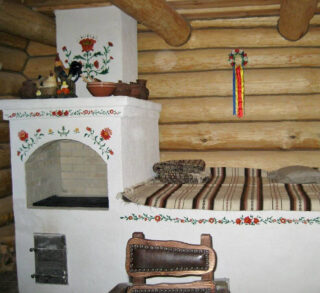
To appreciate the benefits, the Swede is compared to popular stove models in homes and even apartments.
- The Dutch woman is a vertical block with complex chimney ducts and is capable of heating several rooms if brick channels are laid from it to other rooms.
- The Muscovite is a more complicated version of the Swede.Includes the same functional elements, but more efficient.
- The model with a stove bench is a variant of the Russian stove, in which the stove bench is not part of the body, but acts as a separate attached element. This option is very convenient in country houses in a harsh climate. The firebox here is equipped with a hob and additional grates, which allows it to be used as a full-fledged kitchen stove.
Often, the Swede is compared to a heavy, universal interior stove, which includes not only a heating surface, but also a fireplace on the front side. However, in this design, the hearth - open or behind a glass door - is a separate unit. As a rule, the smoke from here goes into a separate chimney. This design is much heavier and more complex.
Dimensions and drawings of the Swedish stove
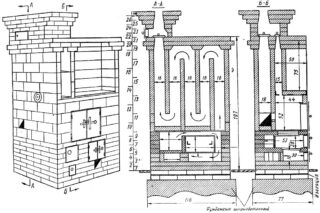
The dimensions of the structure are calculated from the required power. The latter is determined from the area of the premises. It is better to transfer the calculations to a specialist or perform using a special program.
The calculations are necessary for the following reasons:
- a project downloaded from the Internet with a finished drawing may turn out to be low-power for heating a summer cottage;
- ordering in Swedish is complicated despite the external simplicity of the design, and it can be calculated only taking into account the dimensions of the product and the size of the brick;
- the parameters of the chimney can be determined only after calculating the firebox.
The material used is also taken into account in the calculations. The thermal conductivity coefficient of cast iron and steel, for example, is very different. Therefore, to heat and operate a cast iron hob and oven, you will need a different power than for a tin oven.
The Swede is placed between the living room and the kitchen, this is the most rational solution. The front side of the oven can face both the bedroom and the living room. The second option is better, since it is possible not to maintain a comfortable temperature in the bedroom, while it is necessary in the hall.
Often, the body of the furnace, especially with a stove bench, itself acts as a wall if the space between the 2 main walls is small.
The sequence of the construction of the furnace
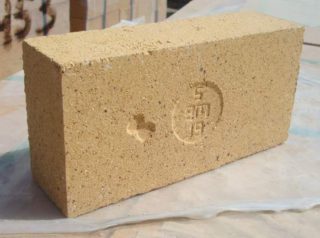
The construction of a structure takes a lot of time and requires high qualifications. If the stove is built into the interior partition, it is recommended to first equip it, and then erect the walls.
Materials (edit)
The highest quality materials are required to fold the Swede. This is important, since the temperature drops here are greater than in the Russian one, and the load on the internal elements is higher. You will need:
- fireclay brick not lower than ШБ-5;
- red brick M-150 or higher;
- fireclay clay;
- cast iron oven - the dimensions are chosen in accordance with the dimensions of the firebox;
- cast iron grate - it is not recommended to make it yourself;
- hob - cast iron is preferable, but iron is allowed;
- the doors are also preferable cast iron, as they burn out much more slowly.
For laying the hull and chimney, take ordinary clay.
Furnace masonry tools
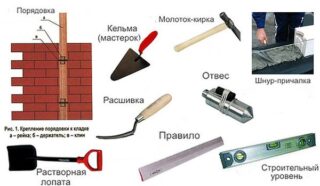
To build a Swede you need the following tools:
- bayonet and shovel, construction mixer for mixing;
- trowel, mason's hammer, rubber mallet;
- usually more than 1.5 m;
- plumb line, square, different levels;
- grinder with a disc for stone and metal;
- tile cutter.
Other adaptations may be required.
Foundation construction
The Swede is a heavy construction. For it, you need to build your own foundation.
- Dig a trench 10-15 cm larger along the perimeter than the dimensions of the body. At the bottom, 20 cm of sand and crushed stone are tamped.
- From a bar with a cross section of 1 cm, they knit the reinforcement and install it in the pit. Formwork is built from plywood or boards.
- The structure is poured with concrete. The top layer is reinforced with another reinforcing mesh.
- After complete drying, the foundation is waterproofed with two or three layers of roofing material.
It is allowed to make a base of brick or by laying crushed stone in layers and pouring it with cement-concrete mortar.
Ordering
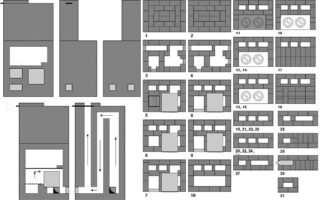
A Swedish stove with an oven and a stove is laid out in the calculated order. The dimensions of the structure itself can be quite varied, but the ratio of the elements changes little in height.
- Two rows are made solid. Clay brick is used.
- For the 3rd row, they take red and chamotte, since here they begin to form an ash pan, an oven compartment and vertical channels. Here, side holes for cleaning are provided and the ash pan door is laid.
- In the 4th row, the passage between the oven and the vault is reduced, and 2 metal strips are attached above the ash pan door.
- At 5, bricks are placed on the strips, a grate is placed and the width of the passage is further reduced. Starting from the 5th row, only fireclay bricks are laid.
- At 6, an entrance to the firebox is formed - for it, the bricks are cut at an angle. Then block the passage and install the oven. In the heating block, chimney ducts are erected strictly according to the drawing.
- On the 7th row, the doors of the firebox are inserted and reinforced with iron bars.
- From 8 to 10 rows they cover the oven, form a combustion chamber. In the 10th row, the firebox and oven are combined. They use red brick here.
- In the 11th row, they form a channel for switching to summer mode. In fireclay bricks, the walls are cut out grooves for a cast-iron plate, an asbestos cord is placed in the gap. Lay the hob, insulating it with iron corners.
- From 12 to 14 it forms the cooking chamber and the channel of the "summer" mode is laid.
- From 15 to 17 rows lay out the supports for the arch above the hob and horizontal channels.
- At 18-19 the vault is closed.
- In rows 20-21, a drying upper niche is laid and a hole is made for cleaning. At 22 - the "summer" channel is divided in two, and at 23 - they are blocked. At 24–26, a small drying chamber is formed, 2 vertical and horizontal channels are combined, and at 28, all channels are blocked.
- At 29, a protrusion is formed for the outlet of the chimney.
This scheme is relevant for a simple Swede - without a fireplace and a separate chimney for it.
Features of pipe laying
The chimney has no original design. Lay it out of red brick on a folded ledge. In the first row, a hole is formed for the flap, and in the next row it is closed.
The chimney is brought out to the roof. At the intersection of the ceiling and roof, it is thermally insulated.
In brick houses, the chimney of the Swedish stove is supplemented with sleeves. The metal insert has smooth walls. Soot is less deposited on them, they function longer.
Useful Tips
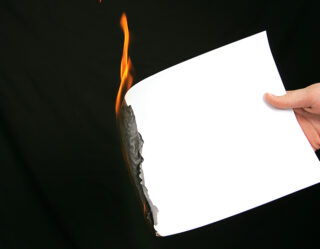
During the construction and inspection of the Swedish stove, the following recommendations are followed.
- After construction, the oven is allowed to dry naturally for at least 2 weeks. Therefore, it is better to build it in the warm season.
- The heating test takes up to 15 days. First, the oven is heated for 3 days only with straw - about 4 kg, then with straw and wood chips. At the next stage, up to 5 kg of dry logs are burned in 2 days, and then, within a week, the duration of heating is increased, using both firewood and coal.
If the Swede has not worked for a long time, soft paper is used for lighting, and then the logs are set on fire.

